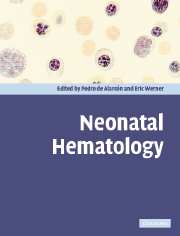Book contents
- Frontmatter
- Contents
- List of contributors
- Foreword
- Preface
- 1 Neonatal hematology: a historical overview
- 2 Disorders of the fetomaternal unit
- 3 Erythropoiesis, red cells, and the approach to anemia
- 4 Anemia of prematurity and indications for erythropoietin therapy
- 5 Hypoplastic anemia
- 6 Hemolytic disease of the fetus and newborn
- 7 Neonatal hemolysis
- 8 Neonatal screening for hemoglobinopathies
- 9 Polycythemia and hyperviscosity in the newborn
- 10 Newborn platelet disorders
- 11 Neutrophil function and disorders of neutrophils in the newborn
- 12 Immunodeficiency diseases of the neonate
- 13 Hemostatic abnormalities
- 14 Transfusion practices
- 15 Umbilical-cord stem-cell transplantation
- 16 Neonatal oncology
- 17 Normal values and laboratory methods
- Index
- References
8 - Neonatal screening for hemoglobinopathies
Published online by Cambridge University Press: 10 August 2009
- Frontmatter
- Contents
- List of contributors
- Foreword
- Preface
- 1 Neonatal hematology: a historical overview
- 2 Disorders of the fetomaternal unit
- 3 Erythropoiesis, red cells, and the approach to anemia
- 4 Anemia of prematurity and indications for erythropoietin therapy
- 5 Hypoplastic anemia
- 6 Hemolytic disease of the fetus and newborn
- 7 Neonatal hemolysis
- 8 Neonatal screening for hemoglobinopathies
- 9 Polycythemia and hyperviscosity in the newborn
- 10 Newborn platelet disorders
- 11 Neutrophil function and disorders of neutrophils in the newborn
- 12 Immunodeficiency diseases of the neonate
- 13 Hemostatic abnormalities
- 14 Transfusion practices
- 15 Umbilical-cord stem-cell transplantation
- 16 Neonatal oncology
- 17 Normal values and laboratory methods
- Index
- References
Summary
Introduction
The history of neonatal screening for sickle cell disease (SCD) and other hemoglobinopathies began 30 years ago with the demonstration that hemoglobin electrophoresis could be applied successfully to samples of umbilical-cord blood or capillary blood collected on filter paper [1–3]. This approach provided adequate differentiation of important adult hemoglobin (Hb) variants, such as sickle hemoglobin (Hb S) and Hb C, from normal adult hemoglobin (Hb A) in the presence of large amounts of fetal hemoglobin (Hb F). Statewide programs initiated in New York in 1975 and Colorado in 1979 demonstrated the feasibility of universal screening by public health laboratories that utilized filter paper samples already being collected for phenylketonuria screening [4, 5]. In 1986, the demonstration that prophylactic penicillin markedly reduces the incidence of pneumococcal sepsis, the leading cause of death in children with SCD, provided a strong incentive for neonatal screening [6]. One year later, a consensus development conference of the National Institutes of Health reviewed evidence that neonatal screening, when linked to timely diagnostic testing, education, and comprehensive medical care, markedly reduces morbidity and mortality from SCD in infancy and early childhood [6–8]. The panel recommended that all neonates in the USA be screened for SCD [9]. Since then, most states in the USA, and a number of other countries, have implemented neonatal screening for hemoglobinopathies.
Approximately 2000 infants with SCD are identified annually by US neonatal screening programs [10, 11].
- Type
- Chapter
- Information
- Neonatal Hematology , pp. 163 - 170Publisher: Cambridge University PressPrint publication year: 2005
References
- 1
- Cited by

